Hagi: Culture & Traditions Guide

Welcome to Hagi, Japan!

Hagi is a historic city located in Yamaguchi Prefecture, Japan. Known for its rich history, beautiful architecture, and traditional culture, Hagi is a must-visit destination in Japan. This guide will help you uncover the unique culture and traditions that make Hagi a special place to explore.
Historical Significance
Hagi has deep historical roots, having been the capital of the feudal domain of Choshu during the Edo period. The city played a crucial role in the Meiji Restoration, a major turning point in Japanese history that led to the end of the samurai era and the modernization of Japan. Visitors can explore the well-preserved samurai district and discover the remnants of Hagi's past glory.
Hagi Castle Town
One of the highlights of Hagi is the Hagi Castle Town, where you can step back in time and experience the atmosphere of ancient Japan. The town is dotted with traditional samurai residences, merchant houses, and temples. Take a leisurely stroll through the narrow streets lined with old wooden buildings and immerse yourself in the serenity and charm of old Japan.
Hagi Castle Ruins
The Hagi Castle Ruins offer a glimpse into Hagi's feudal past. Located on a hill overlooking the city, the ruins provide panoramic views of the surrounding area. Explore the remnants of the castle walls, gates, and watchtowers, and imagine what life was like during the samurai era.
Hagi Pottery
Hagi is renowned for its traditional pottery, which has a history of over 400 years. The distinct style of Hagi ware features earthy colors, subtle textures, and a rustic aesthetic. Visit the Hagi Uragami Museum to learn about the history and techniques of Hagi pottery, and browse through the wide selection of beautifully crafted ceramics at local galleries and shops.
Hagi Yaki-mono Street
For a comprehensive pottery shopping experience, head to Hagi Yaki-mono Street. This bustling street is lined with shops and studios where you can witness the pottery-making process up close. From tea bowls to vases, you'll find a wide range of Hagi ware products to choose from. Don't forget to pick up a unique piece as a souvenir to remember your time in Hagi.
Hagi Traditional Crafts
In addition to pottery, Hagi is also known for its traditional crafts. Visit the Hagi Traditional Crafts Center to see artisans at work and learn about traditional crafts such as bamboo crafts, lacquerware, and weaving. You can even try your hand at some of these crafts under the guidance of skilled craftsmen.
Hagi Chokokan Museum
The Hagi Chokokan Museum is a treasure trove of historical artifacts and cultural treasures. Housed in a Western-style building that once served as a school, the museum showcases a vast collection of samurai armor, weapons, ceramics, and artwork. Gain a deeper understanding of Hagi's past as you explore the exhibits.
Hagi Festivals
Hagi is the proud host of several vibrant festivals throughout the year. One of the most famous festivals is the Hagi Jidai Festival, held in early May, which recreates the Edo period with costumed parades, traditional music, and dance performances. Another notable event is the Hagi Kiriko Festival, where intricately carved paper lanterns are lit up and paraded around the city streets.
Local Cuisine
No visit to Hagi is complete without trying the local cuisine. Sample Hagi's famous regional dishes, such as Hagi beef, a high-quality, juicy beef that is best enjoyed grilled or in a hot pot. Don't miss out on trying the local specialty, "mouthwatering sand," a sweet and savory dessert made with red bean paste and topped with a crunchy cookie.
Getting Around
Hagi is a small city that can easily be explored on foot. However, if you prefer, you can rent a bicycle or use the local bus service to get around. The bus system is convenient and covers most of the popular tourist spots in the city.
Getting There
Hagi can be reached by train or bus from major cities in Japan. The nearest airport is Yamaguchi Ube Airport, which offers domestic flights from Tokyo and Osaka. From the airport, you can take a bus or taxi to Hagi.
Plan Your Visit
Before traveling to Hagi, it's advisable to check the local weather and plan your visit accordingly. The best time to visit is in the spring or autumn when the weather is mild, and the cherry blossoms or fall foliage are in full bloom, adding to the city's beauty.
Explore Hagi's Rich Culture and Traditions
Immerse yourself in the captivating history, stunning architecture, and traditional crafts of Hagi. Discover the deep-rooted culture and traditions that continue to thrive in this charming city. From exploring ancient samurai residences to experiencing the art of pottery-making, Hagi offers a unique and enriching travel experience that you won't want to miss.
